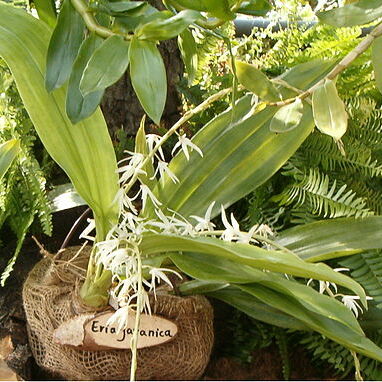Herbs, epiphytic, lithophytic, or rarely terrestrial. Rhizome creeping. Stems pseudobulbous, of 1 distinctly enlarged internode, ovoid, faintly to distinctly angular in transverse section, with 2-4 leaves toward apex; base of pseudobulbs loosely covered by leaf sheaths. Leaves convolute in bud, elliptic to narrowly elliptic, leathery, articulate, tapering at base. Inflorescence axillary, erect, many flowered, pubescent; peduncle subtended by 2 or 3 imbricate sterile bracts arising from opposite leaf base; inflorescence axis covered by brown stellate hairs; floral bracts brown, narrowly ovate to triangular. Flowers opening widely, usually cream-colored to pale yellow and in some species with purple veins or purple markings on column, column foot, and lip, stellate or otherwise, large; ovary angular in cross section, sometimes winged. Sepals narrowly triangular with hairs abaxially; lateral sepals slightly ventrally broadened at base, recurved at apex; mentum distinct. Petals similar to sepals; lip simple or 3-lobed, callus absent or adorned with ridges. Column short, foot incurved; anther cap fleshy, with an obtuse apical median ridge, apex obtuse and covering erect, truncate rostellum; pollinia 8, in 2 groups of 4, each group contained within a distinct 4-chambered pouch at base of anther cap, each pollinium laterally compressed, ± deltoid in lateral view, equal in size, at base attached with white granular caudicles.
More
Epiphytic orchids with crowded, swollen pseudobulbs usually covered or partly covered with thin, papery, white or brown sheaths. Roots very thin, branching freely to form an intricate network. Leaves 1 or 2 per stem, sessile or petiolate, thin to thick, flat or margins folded, held erect. Inflorescence racemose, from upper nodes of pseudobulbs, multi-flowered. Flowers generally small, often not opening widely, some species hardly expanding at all. Exterior surface of tepals glabrous or covered with short, fuzzy hairs; inner surfaces glabrous. Bases of lateral sepals fused to column and/or column foot. Labellum either attached to anterior base of column or hinged to apex of column foot. Labellum lamina unlobed or 3-lobed. Callus with ridges or keels. Column short, with or without basal foot.

